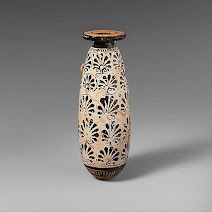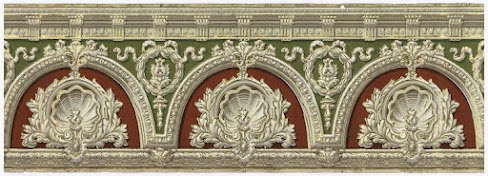Greek Key Pattern: An ancient Motif and Meanders
Greek Key Pattern: An ancient Motif and Meanders
Without a doubt, we've all gone over the 'Greek key', called the 'meander', sooner or later.
A significant number of the patterns we use today in the textile are extremely old... they are ancient! The very name "Greek Key" recommends beginnings from antiquated Greek civilizations, in any case, varieties have been found in Egyptian burial places and on memorable Chinese structures. In fact, the Greek key pattern is the embellishing, line lying configuration considered on ceramic Greek pots to be old as 300 BCE. For millennia, it enhanced everything in Greek life — engineering, floor tiles, paintings.
The Greek key pattern likewise alluded to as a "meander" or even Greek "fret", is a ceaseless line that folds back on itself reproducing the Maeander River which is situated in Turkey. The theme is tracked down richly in design and brightening expressions from the Greek Empire. The Romans utilized the theme and used it in Europe during the Empire Style, or Neoclassic Style, in France, the Regency Style in Britain, and spread to the US in what is known as the Federal style. As indicated by "Psychology Today"; a media association and magazine, including a wide assortment of psychologists, anthropologists, sociologists, and science columnists, late finds show the Greek Key was not just an improving example. It was likewise a kind of solid handclasp, used in old Greek gymnastics, wrestling, and the pankration, a Greek type of military art, as well as in battle.
Key Pattern’s inheritance:
In ancient Greece, the Greek key example shows up in various architectural friezes and on ceramics from the Geometric Period onwards. As a matter of fact, the far and wide use of the Greek Key theme on antiquated Greek jars from the Geometric Period was likely the beginning of the interest in this one-of-a-kind, decorative design. To be honest, it's difficult to follow it straightforwardly from the paleolithic time frame directly to now (since relics have an approach to going unpreserved). Be that as it may, it was there.
Well before Greece took on it, it shows up on elegant lines in Egyptian burial places from the fourth tradition (approximately 2600-2500 BCE). It's a similar course of action of squared mathematical lines, however exquisitely cut into Egyptian stonework.
In the following leg of the Greek key excursion, the example appears in Central America around
900
BCE. The world is as yet where the correspondence between dissimilar topographies — Central
America, Greece, China — is far-fetched.
Thus, the example might not have been passed from one of these societies to the next, yet in
some way or another there it is in Mexico, at the Mitla ruins from 900 BCE.
Crossing to another mainland during that period, we find the fret design next in China
at around a similar time. Here, it is called Rolling Thunder as the lines are said to address
clouds.
The meander is carefully cut into antiquated Chinese bronze vessels as old as 2,000 BCE.
Rolling Thunder is drawn precisely as the Greeks later drew it (as far as we might be concerned
now), however, a few Chinese varieties sport a couple of shut closes that make it seem to be
a Chinese character, or like Chinese grid designs representing the future.
The motif is so profoundly dug in China's set of experiences that even now, multiple thousand
a similar plan winding its strategy for getting around a clay Chinese plate.
we should bounce this way and that in cultures — and jump mainlands. Since Stone structural
pillars in India from 2 AD sport, a wander configuration has antiquated Celtic bunch designs
obviously look like a similar example. Center Eastern vestiges have solid similitudes to the
Meander. Also, Norse metalwork from the 10th century shows productive use of the design,
as do antiquated Peruvian materials and Japanese materials from the eighteenth hundred years.
During the Regency period in England (1811-1820), the fret design partakes in a resurgence
in prominence. The equivalent can be said for the fret design integrated into Art Deco plans (
the 1920s and 30s), and in Hollywood Regency (1920s - 50s), when set fashioners brought the
example onto the cinema.
Each time there's a slight Greek recovery, the key pattern is there. These maze-like,
snake-like, square-shaped motifs consistently have something significant to tell somebody.
A portion of the way of life that embraced the fret design felt it mirrored a snake.
Others thought it portrayed lightning or said it represented endlessness and solidarity
(because the line folds in on itself so impeccably).
To some, it was an image of water waves and the timeless progression of life or a decent
gathering.
- https://www.getty.edu/art/collection/object/103WFJ
- https://www.metmuseum.org/art/collection/search/130007732?rpp=20&pg=7&ft=greek+pottery&pos=125
- https://www.mediastorehouse.com/heritage-images/ancient-greek-pottery-1898-creator-unknown-19777970.html?prodid=73043
- http://rainermarialatzke.com/portfolio/classic-wall-art/
- https://www.touregypt.net/featurestories/picture07112002.htm
- https://www.google.com/search?q=zhou+dynasty+style&espv=2&biw=1280&bih=583&tbm=isch&tbo=u&source=univ&sa=X&ei=XH5aVbqGJJGtogSTn4HYBg&ved=0CDQQsAQ&dpr=1
- https://www.christies.com/lot/lot-an-archaic-bronze-wine-vessel-you-late-6200195/
- https://www.1stdibs.com/blogs/the-study/greek-key/?amp=&epik=dj0yJnU9VWp6d25MdGx1WmU2R2dGNVRqZ1phb09sYWhueHdrWGYmcD0wJm49UXFqWTNwNTBLajFsMWkxMGxKTDZoZyZ0PUFBQUFBR0tIVDdJ
- https://www.artcer.ru/jetnicheskie-stili-v-interere-afrikanskij-vs-egipetskij-yaponskij-vs-kitajskij
- https://www.vogue.com/fashion-shows/resort-2018/chanel/slideshow/collection?epik=dj0yJnU9dVZLSVNRVlp2WUh1bG50NU9CYzBSeEZram5NamFKNTgmcD0wJm49eHU1a3U0T0p1OVNKcmZ2cFhDbjNIQSZ0PUFBQUFBR0tIVUI0#13
- https://web.telegram.org/z/#:~:text=https%3A//www.businessoffashion.com/fashion%2Dweek/2018cruise/chanel/collection/look/1


















Comments
Post a Comment